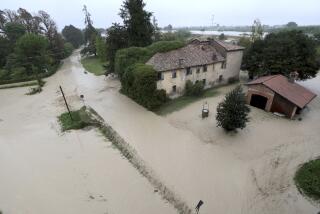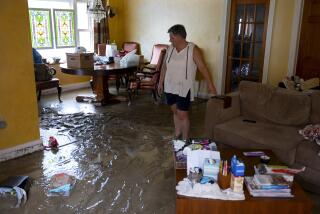Rains Stoke Floods on Upper Mississippi : Weather: New round of storms may force evacuations in some low-lying communities. Two children drown in Minnesota.
CHICAGO — Pelting rain continued to swell the upper reaches of the Mississippi River into a debris-choked torrent Wednesday, and with more storms predicted for the rest of the week, emergency officials braced for the possibility of evacuating some low-lying communities.
At least two people were reported drowned Wednesday along surging tributaries in Minnesota. Authorities reported that an 11-year-old girl drowned while wading in floodwaters near LeCenter, Minn. The body of a 4-year-old St. Paul, Minn., boy who had gone fishing was recovered from the Redwood River near Lynd, Minn.
Officials continued a suspension of barge traffic between St. Paul and St. Louis, a 500-mile stretch used as the major transportation lifeline for shipments of grain, agricultural products and chemicals.
In several riverfront towns, volunteers and National Guard troops lined up in human chains to deliver sandbags that they hope will buttress an extensive system of levees.
But many other areas inundated during the great flood of 1965 have stayed dry because of new levees, reservoirs and flood control projects built over the past 28 years.
“Our dikes are holding up pretty good, but everybody in town’s got their pumps going because the ground is so saturated,” said Norma Rouchotzke, a bartender at a Veterans of Foreign Wars lodge in Subula, Iowa, a river town 40 miles southeast of Dubuque, Iowa. “It’s definitely close to what it was in ’65.”
Waters that rose to 18 feet forced public safety officials to shut down the only bridge connecting the town of 700 inhabitants with neighboring Savanna, Ill.
River levels approaching or topping 20 feet--up to five feet above normal flood stages in some spots--were reported, and more than four inches of rain fell in parts of Iowa overnight.
Near Pleasant Valley, Iowa, floodwaters surging from the Mississippi have reversed the riverward flow of Spencer Creek.
In Davenport, Iowa, a city of 65,000 people that is part of the Quad Cities of Iowa and Illinois, floodwaters expected to crest at a record 22 1/2 feet on Saturday have already lapped more than two blocks into a section of restaurants and tourist haunts.
At least 150 residents have left their homes, and officials say they fear that hundreds more may have to be evacuated if the Duck Creek tributary overflows.
Davenport’s riverboat casino, the President, has been forced to relocate upstream. “I guess people like to gamble, hell or high water,” said city Alderwoman Ruth Reynolds. “But the rest of us are getting a little nervous.”
Not far from Davenport, seven tows with more than 300 barges were stranded on the river, unable to move because locks ahead and behind them are closed.
At least 2,000 grain barges are reportedly stalled along the length of the Mississippi, costing more than $1 million a day in lost revenues, industry officials said.
Disaster areas have been declared in 30 counties in Wisconsin, which estimates $175 million in rain and flood losses, and in 15 counties in Illinois.
Iowa Gov. Terry E. Branstad declared a state of emergency Wednesday along the riverfront.
Branstad toured Davenport and other flood-threatened towns Wednesday with U.S. Agriculture Secretary Mike Espy, who also planned to visit Minnesota, Wisconsin and South Dakota.
Federal officials say they will not be able to estimate crop damage until after the Mississippi returns to normal levels. Some farm industry officials have warned that soybean harvests along the river may suffer losses.
Rock County, Minn., farmer Virgil Schoolmaster said flood erosion and waterlogged soil have turned his soybean and corn fields into earthen pudding and left them smelling like swamps.
“It ruined some crops,” he said. “Other areas I can’t get in to plant. It’s just too wet. It’s too late to plant anything.”
In Minnesota alone, said Donna Wilkens, a specialist with the state’s Agricultural Stabilization and Conservation Service, 700,000 acres of soybeans and corn have not been planted because of flooding and heavy rains.
But Norton Strommen, chief meteorologist for the Agriculture Department’s World Economic Outlook Board, minimized the impact of the flooding. “It shouldn’t be major,” he said. “We have excellent growing conditions for most of the crop areas.”
Times researcher Tracy Shryer contributed to this story.
More to Read
Sign up for Essential California
The most important California stories and recommendations in your inbox every morning.
You may occasionally receive promotional content from the Los Angeles Times.










